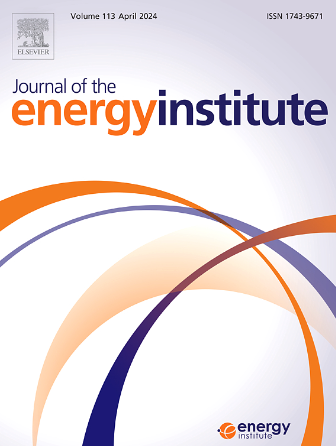Analysis of thermoacoustic instability and emission behaviors of lean premixed biogas/ammonia flame
IF 5.6
2区 工程技术
Q2 ENERGY & FUELS
引用次数: 0
Abstract
Ammonia and biogas are promising renewable fuels that can reduce carbon emissions. This paper studies thermoacoustic instability and emission behaviors of biogas/ammonia co-firing swirl flame. The effects of CO2 proportion in biogas (), ammonia proportion () and equivalence ratio (Φ) on combustion characteristics were considered. A chemical reactor network (CRN) was established to advance comprehension regarding NO emission. The results show that high Φ and are more conducive to simultaneously suppressing thermoacoustic instability and NO emissions. Lower flame appears to have intense thermoacoustic instability when Φ near 0.90, and the instability intensity is significantly weakened when exceeds 20%. The CO2 in the mixture inhibits NO formation but promotes CO formation. The CRN results show that CO2 in biogas reduces NO emissions by inhibiting the HNO pathway and promoting the NHi pathway. This study furnishes a foundation for advancing clean and efficient low-carbon combustion systems.
求助全文
约1分钟内获得全文
求助全文
来源期刊

Journal of The Energy Institute
工程技术-能源与燃料
CiteScore
10.60
自引率
5.30%
发文量
166
审稿时长
16 days
期刊介绍:
The Journal of the Energy Institute provides peer reviewed coverage of original high quality research on energy, engineering and technology.The coverage is broad and the main areas of interest include:
Combustion engineering and associated technologies; process heating; power generation; engines and propulsion; emissions and environmental pollution control; clean coal technologies; carbon abatement technologies
Emissions and environmental pollution control; safety and hazards;
Clean coal technologies; carbon abatement technologies, including carbon capture and storage, CCS;
Petroleum engineering and fuel quality, including storage and transport
Alternative energy sources; biomass utilisation and biomass conversion technologies; energy from waste, incineration and recycling
Energy conversion, energy recovery and energy efficiency; space heating, fuel cells, heat pumps and cooling systems
Energy storage
The journal''s coverage reflects changes in energy technology that result from the transition to more efficient energy production and end use together with reduced carbon emission.
 求助内容:
求助内容: 应助结果提醒方式:
应助结果提醒方式:


